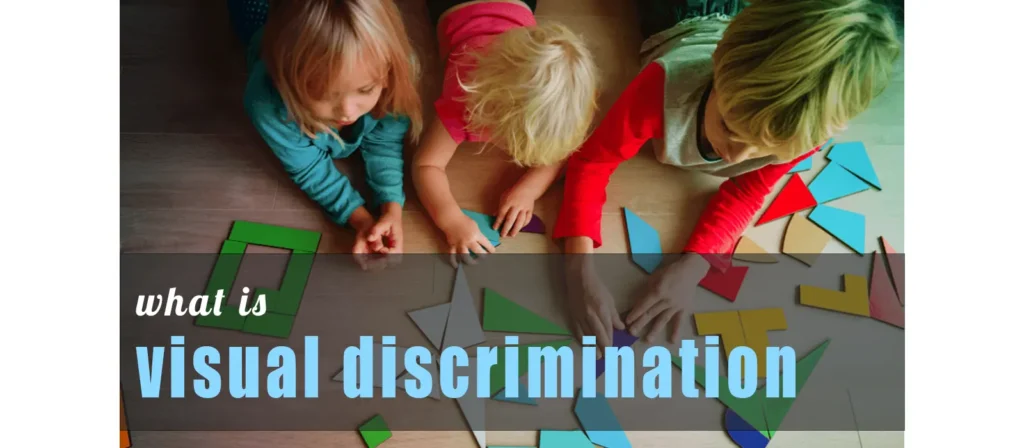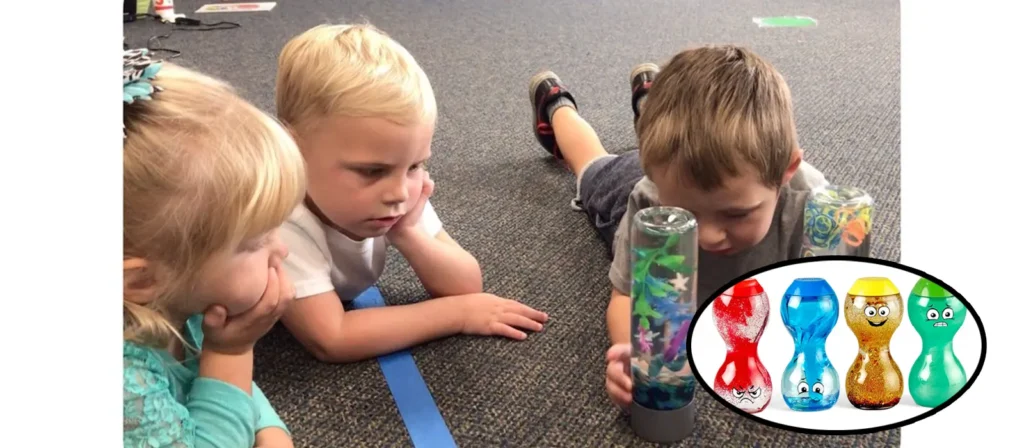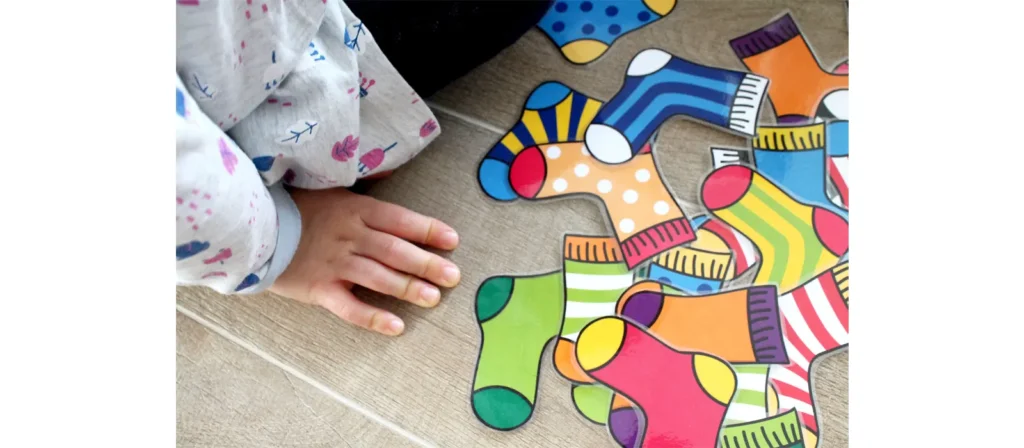Visual discrimination activities are simple tasks or games designed to help children practice seeing and identifying the differences and similarities between objects. These activities often include sorting, matching, finding, or comparing items based on visual details like shape, size, color, or position.
These activities support the early development of visual processing skills by encouraging children to pay close attention to what they see. They are usually hands-on, playful, and easy to adapt for different age groups, making them a natural fit for home, preschool, or early childhood classrooms.
Visual discrimination activities are especially helpful for children between the ages of 2 and 6, as this is when they are building the foundation for future reading, writing, math, and motor coordination. These tasks can be part of daily routines, sensory play, or structured learning time, depending on the child’s developmental stage. For example, a toddler picking out a red block from a pile of mixed colors is already engaging in a basic visual discrimination activity.
This article will introduce six effective and engaging visual discrimination activities tailored for early learners, helping parents and educators support children’s growth through everyday play.
What is Visual Discrimination?
According to Taylor & Rodriguez (2022), visual discrimination occurs by the eyes and brain detecting differences in objects, utilizing working memory and stored memory to determine distinct differences or matched features. This visual skill is necessary for reading, writing, math skills, play, activities of daily living, and essentially all aspects of utilizing visual input.
For young children, this means being able to tell objects apart based on their size, shape, color, or position. It helps them recognize patterns, match items that look alike, and understand how things are different from one another.

Visual discrimination allows a child to tell the difference between a square and a rectangle, or to match two socks with the same pattern. It’s a basic skill that helps children make sense of the world around them by using their eyes to spot details.
This skill is especially important in early learning, because many daily tasks and classroom activities involve looking closely and noticing what makes things look the same or different. Children use visual discrimination when they look at letters in the alphabet, choose the right puzzle piece, or find a toy that matches.
Implications of Poor Visual Discrimination
When young children have difficulty with visual discrimination, it can affect many areas of their daily life and learning. These challenges often show up in subtle ways, especially during play and early academic tasks.
Some common signs and impacts of poor visual discrimination include:
- Letter and number confusion
Children may mix up similar-looking letters such as “p” and “q” or numbers like “3” and “8,” which can slow early reading and math progress. - Difficulty completing puzzles or matching games
Tasks that require spotting small differences such as matching shapes or finishing puzzles can be frustrating or avoided altogether. - Mistakes in copying or reading
Children might skip words or lines when reading or write incorrect letters when copying from a board or book. - Trouble with organizing or sorting objects
Sorting socks, grouping toys by color or size, or placing items in the correct order may be harder for them to do independently. - Reduced confidence during visual tasks
When these struggles happen repeatedly, children may become discouraged or avoid tasks that require careful visual attention. - Slower development of other skills
Since visual discrimination supports language, motor, and cognitive development, delays in this area can indirectly affect those too.
These challenges are not permanent, but early awareness makes a big difference. With the right activities and support, children can strengthen their visual processing skills in a way that feels fun and natural.
Benefits of teaching young children visual discrimination
Building strong visual discrimination skills in early childhood lays the groundwork for many areas of development. When children learn to notice small visual differences, they become more confident, focused, and prepared for academic and everyday tasks. The following are key benefits that show why it is worth introducing visual discrimination activities at an early age.
Cultivates visual perception
Visual perception is how the brain understands what the eyes see. When children practice visual discrimination, they become better at noticing details, patterns, and changes in their environment. This helps them navigate picture books, follow visual instructions, and recognize important differences in the world around them. Strong visual perception supports early literacy, problem solving, and classroom participation.
Enhances cognitive abilities
Visual discrimination activities that involve comparing, sorting, and matching help strengthen a child’s memory, attention, and reasoning. These are core cognitive skills that children use not only during learning but also while playing, exploring, and solving problems. When children practice visual discrimination regularly, they are training their brains to think more logically and respond more accurately to visual information.
Supports eye-hand coordination
Visual discrimination strengthens the connection between visual input and physical response. As children learn to notice differences in shapes, sizes, and positions, they begin to coordinate their eye movements with hand actions more effectively. This skill plays a vital role in the development of fine motor control, helping children become more precise, steady, and confident in tasks that require accuracy and careful movement.

Supports language development
Visual discrimination helps children notice subtle differences between letters, symbols, and word patterns. This is especially important when they begin to learn phonics and letter recognition. Children with strong visual skills often find it easier to recognize sight words, understand word structures, and make sense of written language. These early connections lay a strong foundation for future reading and writing success.
6 Visual Discrimination Activities
Sensory Bottle Visual Tracking Activity
This activity is a type of sensory play that focuses on visual tracking and attention. A sensory bottle visual tracking activity involves using a clear, sealed container filled with a mix of liquid and small, colorful objects. These objects could be beads, glitter, buttons, or themed trinkets. When the bottle is tilted or shaken, the floating items slowly travel through the liquid, encouraging the child to follow the movement with their eyes.
Invite the child to sit comfortably in a quiet space and slowly tilt the bottle from side to side. As the contents drift through the liquid, encourage the child to watch the objects as they move from one end to the other. Ask simple guiding questions like, “Can you follow the red star all the way across?” or “What happens when you turn the bottle upside down slowly?”
As the child tracks the movement of the floating objects, they practice coordinating their eye movements smoothly and precisely across space. This process strengthens visual tracking skills, which are essential for following lines of text when reading, copying from a board, or keeping focus on moving targets. The slow, fluid motion also encourages sustained visual attention, helping the child build the ability to concentrate for longer periods without distraction. In addition, watching the predictable, rhythmic flow of objects can have a calming effect, which supports self-regulation and helps prepare children for transitions or focused tasks in learning environments.

Brown Stair and Pink Tower Size Comparison Activity
This activity combines two foundational Montessori materials, the Brown Stair and the Pink Tower, to help children refine their understanding of size, thickness, and visual gradation. The Brown Stair consists of ten wooden prisms that vary in height and width but share the same length, while the Pink Tower features ten pink cubes that vary uniformly in all three dimensions.
When used together, children are encouraged to compare, align, and contrast the two sets. For example, a child might place a pink cube on top of a brown prism to see how their widths relate, or arrange both materials side by side to explore differences in size and shape. This type of hands-on comparison invites close observation and reinforces visual discrimination by focusing on small differences in dimension and proportion.
When used together, children are encouraged to compare, align, and contrast the two sets. For example, a child might place a pink cube on top of a brown prism to see how their widths relate, or arrange both materials side by side to explore differences in size and shape. This type of hands-on comparison invites close observation and reinforces visual discrimination by focusing on small differences in dimension and proportion.

Sock matching
Sock matching is a simple, everyday activity that builds visual discrimination by encouraging children to identify subtle differences in patterns, colors, and sizes. Whether done with freshly washed laundry or a set of intentionally mismatched socks prepared for learning, the task requires children to compare two items side by side and decide whether they match.
This visual discrimination activities strengthens attention to detail and visual memory. Children must look closely at features like stripe direction, color shades, heel shapes, or pattern placement to find a true match. It also helps them build sorting and classification skills as they learn to group similar items and reject those that do not belong together.
Because it uses real objects from daily life, sock matching feels familiar and meaningful to children. It requires no special materials, making it easy to repeat regularly in both home and classroom settings. With consistent practice, children become more confident in spotting visual similarities and differences, an essential step in developing strong visual processing skills.

Build Skills With Puzzle Toys
Puzzle toys involve selecting individual pieces and placing them into the correct spaces based on how they look. For early learners, this might start with simple knob puzzles, where each piece has a distinct shape or image. As children become more experienced, they can progress to larger image-based puzzles with multiple pieces that form a full picture.
The activity typically begins by spreading out all the puzzle pieces and placing the board or frame in front of the child. The child then looks for clues on each piece, such as edge shapes, colors, or parts of an image, to figure out where it belongs. Some puzzles may include outlines or visual hints in the tray to guide placement, while others require the child to rely on memory and observation.
Puzzle play can be done independently or with gentle guidance. Adults might offer prompts such as “Can you find the piece with the bear’s nose?” or “Which piece has a straight edge?” to help children think about what they are looking at. Puzzle difficulty can be adjusted by choosing simpler or more complex designs based on the child’s developmental level.

Coin sorting
Coin sorting is a hands-on activity that encourages children to examine and organize coins based on visual features such as size, color, texture, and markings. To set up, gather a small collection of coins, preferably of different denominations and styles, and place them in a shallow tray or bowl. Provide small containers or labeled sections for sorting.
Children begin by picking up one coin at a time and deciding where it belongs. They might sort coins by value, by size, or by whether the edges are smooth or ridged. For younger children who are not yet familiar with coin values, sorting by visual characteristics like color or diameter is an accessible starting point.
This activity can be done at a table or on a flat mat. Using real coins adds a sense of authenticity, but pretend coins or tokens can be used as well, especially in early childhood settings. Coin sorting sessions can be kept short and repeated regularly, allowing children to become familiar with the task and more confident in making visual judgments over time.

Fine Detail Observation Activity
This visual discrimination activities involves inviting children to observe small objects closely using simple STEM tools such as a magnifying glass, observation jar, or mini microscope. Begin by gathering a few interesting items such as leaves, flower petals, pebbles, pieces of fabric, or safe insects in a closed jar. Place them on a tray alongside magnification tools.
Children are encouraged to look at each item one by one, noticing fine details like lines, textures, color variations, or tiny shapes that are not immediately visible to the naked eye. With a magnifying tool in hand, they can spend time observing and even describing or drawing what they see. The setup can include printed cards with visual prompts or questions to guide their attention.
This activity works best when presented in a quiet, focused space. Children can work alone or in pairs, taking turns examining and comparing the details of each object. Rotating the items regularly keeps the experience fresh and encourages repeated practice.

Kirimkan pesan kepada kami jika Anda memiliki pertanyaan atau meminta penawaran harga. Pakar kami akan membalas Anda dalam waktu 48 jam dan membantu Anda memilih produk yang tepat sesuai keinginan.
Tanya Jawab Umum
What age should children start visual discrimination activities?
Visual discrimination skills begin developing in infancy and can be supported as early as age two. Simple matching and sorting games are ideal for toddlers, while preschoolers can engage in more structured tasks like puzzles and sensory activities.
Are visual discrimination activities suitable for children with learning difficulties?
Yes. These activities are especially helpful for children who struggle with attention, reading readiness, or spatial awareness. The hands-on and visual nature of these tasks makes them accessible and non-intimidating for many learners.
How often should I include visual discrimination activities in a child’s routine?
Incorporating these activities a few times a week, either during play or structured learning time, is a good starting point. Consistency matters more than frequency, and even short sessions can make a difference over time.
Do I need special materials to start visual discrimination activities at home?
Not at all. Many effective activities, like sock matching or coin sorting, use everyday items. If desired, materials like sensory bottles or puzzle toys can be added to enrich the experience, but they are not required.
How do I know if a child is improving their visual discrimination skills?
Look for signs such as improved accuracy in matching, quicker recognition of differences, fewer mix-ups with similar items, or more confidence when tackling puzzles and visual tasks.
Can visual discrimination activities be used in group settings?
Absolutely. Many of these tasks can be done in pairs or small groups, promoting communication and cooperation while still focusing on individual observation skills.
Kesimpulan
Visual discrimination activities play a vital role in helping young children notice, compare, and respond to visual details in their surroundings. By introducing these activities early, caregivers and educators can support the development of observation, attention, and cognitive skills in a playful and meaningful way.
Each of the six visual discrimination activities shared in this article offers a practical way to strengthen a child’s ability to spot similarities and differences through real-world tasks. From matching socks to using a magnifying glass, these activities create opportunities for focused, hands-on learning.
Incorporating visual discrimination activities into everyday routines helps children build confidence and accuracy in how they process visual information. Whether at home or in the classroom, these simple tools lay the foundation for strong learning habits that support reading, writing, problem solving, and more.




